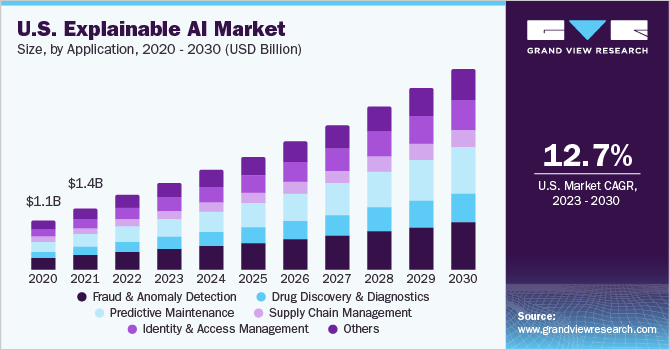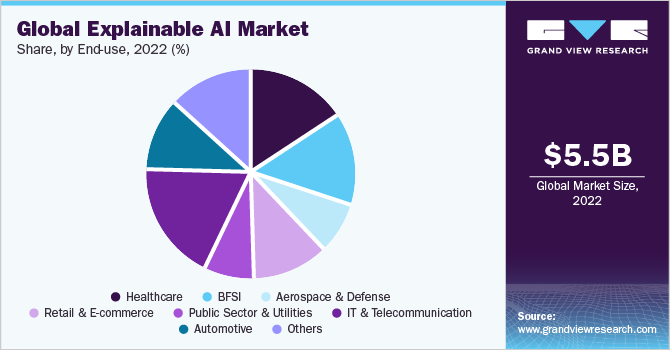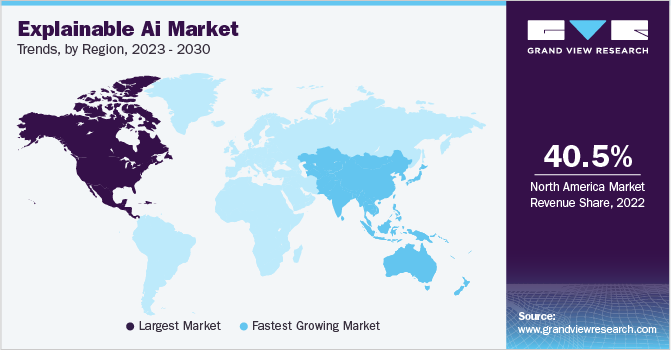- Home
- »
- Next Generation Technologies
- »
-
Explainable AI Market Size, Share & Growth Report, 2030GVR Report cover
![Explainable AI Market Size, Share & Trends Report]()
Explainable AI Market Size, Share & Trends Analysis Report By Component, By Deployment, By Application (Fraud & Anomaly Detection, Drug Discovery & Diagnostics, Predictive Maintenance), By End-use, By Region, And Segment Forecast, 2023 - 2030
- Report ID: GVR-4-68040-074-5
- Number of Report Pages: 110
- Format: PDF, Horizon Databook
- Historical Range: 2017 - 2021
- Forecast Period: 2023 - 2030
- Industry: Technology
Explainable AI Market Size & Trends
The global explainable AI market size was valued at USD 5.49 billion in 2022 and is expected to grow at a compound annual growth rate (CAGR) of 18.0% from 2023 to 2030. Explainable AI (XAI) refers to the development and deployment of artificial intelligence systems that can provide human-interpretable explanations for their decision-making processes. While traditional AI models like deep neural networks can achieve high accuracy in tasks such as image recognition or natural language processing, they often lack transparency and can be considered "black boxes" due to their complex internal workings.

XAI is used across various industries which is fueling the growth of the market. For instance, XAI, used in medical diagnosis and treatment recommendation systems, helps doctors and healthcare professionals understand and trust the decisions made by AI algorithms. Explainable models provide explanations for diagnoses, suggest potential treatments, and highlight relevant medical factors, enabling healthcare practitioners to make more informed decisions.
Emerging technological advancements and the development of AI in North America are propelling the growth of the XAI market. Regulatory bodies in the U.S., including the Federal Trade Commission (FTC) and the Food and Drug Administration (FDA), have shown an increasing interest in the transparency and explainability of AI systems. They have emphasized the need for companies to provide clear explanations for AI-driven decisions, particularly in areas like consumer protection, algorithmic fairness, and healthcare. These regulatory considerations encourage the development and adoption of XAI practices to ensure compliance and mitigate potential risks associated with non-transparent AI systems in this region.
Explainable AI has many advantages, including improved inventory management and greater retention of clients through playing a significant role in advancing customer retention strategies by providing transparency, building trust, and improving customer satisfaction. A key to maximizing an AI model's performance is knowing its shortcoming. It is simpler to improve AI models when we better understand why they failed.
Explainable AI is an effective tool for finding system problems and eliminating biases in the data and increasing user confidence. Explainable AI helps validate estimates so that AI models can be improved, and novel insights can be gained to address the issue. For instance, in medical diagnosis, XAI provides explanations for the predictions made by AI systems, allowing medical professionals to validate the accuracy of the diagnoses and identify potential errors or biases.
Component Insights
Based on components, the market is bifurcated into solutions and services. The solution segment accounted for the largest revenue share of 82.03 % in 2022 and is expected to continue its dominance over the forecast period. The growth of the solution segment can be attributed to factors such as the growing complexities of AI models, lack of standardization, fraudulent activities, and others.
Fraud detection is a major application area of explainable AI where it helps predict fraudulent attacks and define which attack has a higher threat. Cybersecurity is a growing concern for businesses and governments. Vendors of cybersecurity solutions are increasingly using AI and explaining an AI algorithm's decisions brings several benefits, including greater confidence in the system and a better understanding of its operation. Explainable AI solutions are being applied in several areas of cybersecurity, fueling the market growth.
Explainable AI (XAI) consulting services specialize in helping organizations adopt and implement AI solutions that are transparent, interpretable, and accountable. These services focus on ensuring that AI models and systems can explain their decisions and behaviors, enhancing trust, understanding, and compliance, which is driving the market growth. XAI consultants work with organizations to develop a strategy and roadmap for incorporating explainability into their AI initiatives.
Innovative offerings by key players in the market, for instance, Google Cloud, which offers Explainable AI as a service, providing tools and frameworks to enhance the interpretability of AI models, is propelling the explainable AI market. It includes features like integrated gradients and feature importance, which help users understand how to input features to contribute to model predictions.
Deployment Insights
Based on deployment, the market is segmented into cloud and on-premises. The on-premises segment held the largest revenue share of 55.73% in 2022. Using on-premises explainable AI can provide several benefits, such as improved data security, reduced latency, and increased control over the AI system. Additionally, it may be preferable for organizations subject to regulatory requirements limiting the use of cloud-based services.
Organizations use various techniques such as rule-based systems, decision trees, and model-based explanations to implement on-premises explainable AI. These techniques provide insights into how the AI system arrived at a particular decision or prediction, allowing users to verify the system’s reasoning and identify potential biases or errors.
Major players across various industry verticals, especially in the BFSI, retail, and government, prefer XAI deployed on-premises, owing to its security benefits. For instance, the financial services company JP Morgan uses explainable AI on-premises to improve fraud detection and prevent money laundering. The system uses machine learning to analyze large volumes of data, identify potentially fraudulent activities, and provide clear and transparent explanations for its decisions.
Similarly, IBM, the technology company, provides an on-premises explainable AI platform termed Watson OpenScale, which helps organizations manage and monitor the performance and transparency of their AI systems. The platform provides clear explanations for AI decisions and predictions and allows organizations to track and analyze the data used to train their AI models.
Application Insights
Based on application, the market is segmented into fraud and anomaly detection, drug discovery & diagnostics, predictive maintenance, supply chain management, identity and access management, and others. Artificial intelligence (AI) plays a crucial role in fraud management. The fraud and anomaly detection segment accounted for the largest revenue share of 23.86% in 2022.
Machine Learning (ML) algorithms, a component of AI, can examine enormous amounts of data to identify trends and anomalies that could indicate fraudulent activity. Systems for managing fraud powered by AI can detect and stop various frauds, including financial fraud, identity theft, and phishing attempts. They can also change and pick up on new fraud patterns and trends, thereby increasing their detection.
The prominent use of XAI in manufacturing with predictive maintenance is propelling the market growth. XAI predictive analysis in manufacturing involves using interpretable AI models to make predictions and generate insights in the manufacturing industry. Explainable AI techniques are used to develop models that predict equipment failures or maintenance needs in manufacturing plants. By analyzing historical sensor data, maintenance logs, and other relevant information, XAI models identify the key factors contributing to equipment failures and provide interpretable explanations for the predicted maintenance requirements.
Moreover, explainable AI models leverage predictive analysis in quality control processes. By analyzing production data, sensor readings, and other relevant parameters, XAI models can predict the likelihood of defects or deviations in manufacturing processes. The models can also provide explanations for the factors contributing to quality issues, helping manufacturers understand the root causes and take corrective actions.
End-use Insights
Based on end-use, the market is segmented into healthcare, BFSI, aerospace & defense, retail and e-commerce, public sector & utilities, it & telecommunication, automotive, and others. IT & telecommunication sector accounted for the highest revenue share of 17.99% in 2022. The rollout of 5G and the Internet of Things (IoT) is enabling organizations and individuals to collect more real-world data in real time. Artificial intelligence (AI) systems can use this data to become increasingly sophisticated and capable.
Mobile carriers can enhance connectivity and their customers' experiences thanks to AI in the telecom sector. Mobile operators can offer better services and enable more people to connect by utilizing AI to optimize and automate networks. For instance, While AT&T anticipates and prevents network service interruptions by utilizing predictive models that use AI and statistical algorithms, Telenor uses advanced data analytics to lower energy usage and CO2 emissions in its radio networks. AI systems can also support more personalized and meaningful interactions with customers.

Explainable AI in BFSI is anticipated to give financial organizations a competitive edge by increasing their productivity and lowering costs while raising the quality of the services and goods they provide to customers. These competitive advantages can subsequently benefit financial consumers by delivering higher-quality and more individualized products, releasing data insights to guide investment strategies, and enhancing financial inclusion by enabling the creditworthiness analysis of customers with little credit history. These factors are anticipated to augment the market growth.
Regional Insights
North America dominated the market with a share of 40.52% in 2022 and is projected to grow at a CAGR of 13.4% over the forecast period. Strong IT infrastructure in developed nations such as Germany, France, the U.S., the UK, Japan, and Canada is a major factor supporting the growth of the explainable AI market in these countries.
Another factor driving the market expansion of explainable AI in these countries is the substantial assistance from the governments of these nations to update the IT infrastructure. However, developing nations like India and China are expected to display higher growth during the forecast period. Numerous investments that are appropriate for the expansion of the explainable AI business are drawn to these nations by their favorable economic growth.

Asia Pacific is anticipated to grow at the fastest CAGR of 24.8% during the forecast period. Significant advancements in technology in Asia Pacific countries are driving market growth. For instance, in February 2021, a new system built on the 'explainable AI' principle was developed by Fujitsu Laboratories and Hokkaido University in Japan. It automatically shows users the steps they need to do to obtain a desired result based on AI results about data, such as those from medical exams.
Key Companies & Market Share Insights
A number of international and local businesses compete in the fragmented explainable AI market. The key players are investing in research & development (R&D) to develop advanced solutions and gain a competitive edge in the market. Additionally, they are forming alliances and merging with other companies as the market is characterized by innovation, disruption, and quick change.
In March 2023, GyanAI released its initial explainable Language Model and Research Engine. Based on its unique technology, Gyan fulfills the promise of explainable AI by using a model that understands "meaning" as similarly as possible to how people have done it. Gyan is entirely explicable, and a user may follow the trail of its output to its origin. It can explain its results. Gyan produces a mixture of generative and extractive writing.
Similarly, in March 2023, Amelia, an AI firm, partnered with Monroe Capital and BuildGroup, which will provide financial capital and business leadership. The strategic alliance speeds up market acceptance of Amelia's AI products. BuildGroup, an Austin-based company that creates high-growth digital companies, and Monroe Capital, an elite boutique asset management company specializing in private credit markets, are leading the $175 million transaction. With this round of funding, Amelia has the resources necessary to maintain its market-leading position and intensify its commitment to providing its clients with cutting-edge, understandable AI products. Some prominent players in the global explainable AI market include:
-
Amelia US LLC
-
BuildGroup
-
DataRobot, Inc.
-
Ditto.ai
-
DarwinAI
-
Factmata
-
Google LLC
-
IBM Corporation
-
Kyndi
-
Microsoft Corporation
Explainable AI Market Report Scope
Report Attribute
Details
Market size value in 2023
USD 6.59 billion
Revenue forecast in 2030
USD 21.06 billion
Growth rate
CAGR of 18.0% from 2023 to 2030
Base year for estimation
2022
Historical data
2017 - 2021
Forecast period
2023 - 2030
Quantitative units
Revenue in USD billion and CAGR from 2023 to 2030
Report coverage
Revenue forecast, company ranking, competitive landscape, growth factors, and trends
Segments covered
Component, deployment, application, end-use, region
Regional scope
North America; Europe; Asia Pacific; Latin America; MEA
Country scope
U.S.; Canada; U.K.; Germany; France; China; India; Japan; South Korea; Australia; Brazil; Mexico; UAE; Saudi Arabia; South Africa
Key companies profiled
Amelia US LLC; BuildGroup; DataRobot, Inc.; Ditto.ai; DarwinAI; Factmata; Google LLC; IBM Corporation; Kyndi; Microsoft Corporation
Customization scope
Free report customization (equivalent up to 8 analyst’s working days) with purchase. Addition or alteration to country, regional, and segment scope
Pricing and purchase options
Avail customized purchase options to meet your exact research needs. Explore purchase options
Global Explainable AI Market Report Segmentation
This report forecasts revenue growth at global, regional, and country levels and provides an analysis of the latest industry trends in each of the sub-segments from 2017 to 2030. For this study, Grand View Research has segmented the global explainable AI market report based on component, deployment, application, end-use, and region:
-
Component Outlook (Revenue, USD Billion, 2017 - 2030)
-
Solution
-
Services
-
-
Deployment Outlook (Revenue, USD Billion, 2017 - 2030)
-
Cloud
-
On-premises
-
-
Application Outlook (Revenue, USD Billion, 2017 - 2030)
-
Fraud and Anomaly Detection
-
Drug Discovery & Diagnostics
-
Predictive Maintenance
-
Supply Chain Management
-
Identity and Access Management
-
Others
-
-
End-use Outlook (Revenue, USD Billion, 2017 - 2030)
-
Healthcare
-
BFSI
-
Aerospace & Defense
-
Retail and E-commerce
-
Public Sector & Utilities
-
IT & Telecommunication
-
Automotive
- Others
-
-
Regional Outlook (Revenue, USD Billion, 2017 - 2030)
-
North America
-
U.S.
-
Canada
-
-
Europe
-
U.K.
-
Germany
-
France
-
-
Asia Pacific
-
China
-
India
-
Japan
-
South Korea
-
Australia
-
-
Latin America
-
Brazil
-
Mexico
-
-
Middle East & Africa
-
Saudi Arabia
-
UAE
-
South Africa
-
-
Frequently Asked Questions About This Report
b. The global explainable AI market accounted for USD 5.49 billion in 2023 and is projected to reach USD 21.06 billion by 2030
b. The market is estimated to grow at a compound annual growth rate of 18.0% during the forecast period 2023-2030
b. In terms of component, solution segment accounted for the largest share in the global explainable AI market in 2023
b. Key players covered in the report include Amelia US LLC, BuildGroup, DataRobot, Inc., Ditto.ai, DarwinAI, Factmata, Google LLC, IBM Corporation, Kyndi, Microsoft Corporation
b. The increase in technologically advanced solutions and the rising need for automation are prime factors boosting the demand for an explainable AI market. The transparency in the process offered by the explainable AI further boosts their adoption across multiple end-use sectors, globally.
Share this report with your colleague or friend.
![gvr icn]()
NEED A CUSTOM REPORT?
We can customize every report - free of charge - including purchasing stand-alone sections or country-level reports, as well as offer affordable discounts for start-ups & universities. Contact us now
![Certified Icon]()
We are GDPR and CCPA compliant! Your transaction & personal information is safe and secure. For more details, please read our privacy policy.
We are committed towards customer satisfaction, and quality service.
"The quality of research they have done for us has been excellent."





